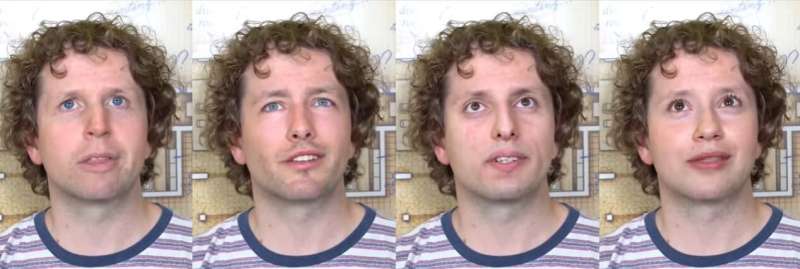July 1, 2020 report
Disney makes face swapping more believable

It may sound contradictory, but deepfakes are becoming more real.
Deepfakes, which refer to the swapping of video or still images of an individual with the likeness of another person, have become wildly popular on the Internet over the past three years. They hold great potential for entertainment and humor, but they also carry foreboding capacity for scandal, fraud and even geopolitical upheaval.
Disney Research Studios announced this week that it has developed a process that automates deepfake production with a fidelity greater than previously achieved.
"To the best of our knowledge, this is the first method capable of rendering photo-realistic and temporally coherent results at megapixel resolution," Disney stated on its website Monday.
Disney's approach uses what are known as generative adversarial networks that employ algorithms for neural face swapping using multiple images of different people. It pinpoints numerous facial motions and captures light and contrast details in videos to ensure smooth, lifelike facial transitions.
Although on the small screen Disney's latest advance may not reveal major improvements, it is on larger screens where the results shine.
A traditional deep fake app can generate lifelike images limited to 256 x 256 pixels. Disney's new approach expands that to 1024 x 1024 pixels.
Disney researchers say the movies made with the older VFX approach, while "impressive," are "expensive to produce and typically take many months of work to achieve mere seconds of footage." The new approach does not require constant oversight in production and can be accomplished in as little as a few hours.
Deepfake imagery has been utilized in recent movies such as Disney's "Rogue One: A Star Wars Story," in which virtual models for the late actors Carrie Fisher and Peter Cushing were used. Early viral videos displaying deepfake trickery include one of former President Obama supposedly uttering obscenities about President Trump, Mark Zuckerberg "admitting" that Facebook's true goal is to manipulate and exploit its users and numerous clips of actor Nicolas Cage's face replacing other actors in famous movie scenes.
Interestingly, thanks to Disney's technological advances of accurately morphing an actor's face onto a virtual model, a movie about the Vietnam War slated for release later this year titled "Finding Jack" will feature a heartthrob actor who was killed in a car crash 65 years ago, James Dean.
And in a sign of expansive creativity—or the end of civilization, depending on how you view such things—there has been an explosive growth of deepfake pornography. Users in online communities such as Reddit are sharing clips displaying the faces of well-known actors and politicians or simply personal acquaintances that were swapped with images of porn stars engaging in explicit activities. By the end of last year, 96 percent of online deepfake videos were porn, according to a report by cybersecurity firm Deeptrace. In almost all instances, the images were used without the subjects' permission.
So popular was this new genre of fake porn that a $50 Windows app using artificial intelligence to scan pictures of women and "undress" them was uploaded and withdrawn within a single day last summer following an immediate backlash.
If the proliferation of fake sex tapes is spooky, the possibilities of political subterfuge are even more frightening.
Given the unsettling proliferation of forged news items and imagery flooding social media during a time of extreme unrest, the prospect of organized efforts to sabotage the political process is very real.
The Brookings Institution examined the possible havoc deepfake efforts could stir. Such content, it said in a recent report, could lead to "distorting democratic discourse; manipulating elections; eroding trust in institutions; weakening journalism; exacerbating social divisions; undermining public safety; and inflicting hard-to-repair damage on the reputation of prominent individuals, including elected officials and candidates for office."
NYU Professor Nasir Memon put it this way: "The man in front of the tank at Tiananmen Square moved the world. Nixon on the phone [in secretly recorded conversations] cost him his presidency. Images of horror from concentration camps finally moved us into action. If the notion of not believing what you see is under attack, that is a huge problem. One has to restore truth in seeing again."
More information: High-Resolution Neural Face Swapping for Visual Effects, studios.disneyresearch.com/202 … -for-visual-effects/
© 2020 Science X Network















